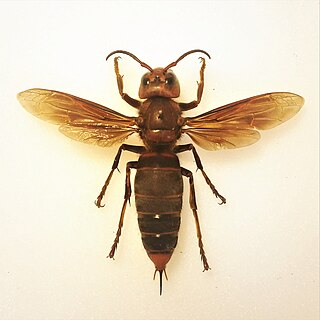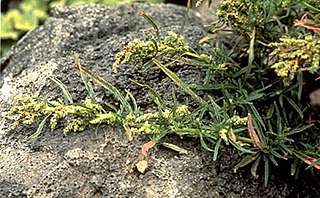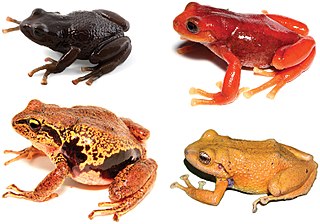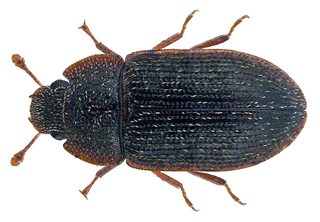
Sorghum is a genus of about 25 species of flowering plants in the grass family Poaceae. Some of these species have grown as cereals for human consumption and some in pastures for animals. One species, Sorghum bicolor, was originally domesticated in Africa and has since spread throughout the globe. Seventeen of the 25 species are native to Australia, with the range of some extending to Africa, Asia, Mesoamerica, and certain islands in the Indian and Pacific Oceans. One species is grown for grain, while many others are used as fodder plants, either cultivated in warm climates worldwide or naturalized in pasture lands. Sorghum is in the subfamily Panicoideae and the tribe Andropogoneae.

Weston is a city in Lewis County, West Virginia, United States. The population was 4,110 at the 2010 census. It is the county seat of Lewis County, and home to the Museum of American Glass in West Virginia and the Trans-Allegheny Lunatic Asylum.

Huntsman spiders, members of the family Sparassidae, are known by this name because of their speed and mode of hunting. They are also called giant crab spiders because of their size and appearance. Larger species sometimes are referred to as wood spiders, because of their preference for woody places. In southern Africa the genus Palystes are known as rain spiders or lizard-eating spiders. Commonly they are confused with baboon spiders from the Mygalomorphae infraorder, which are not closely related.

The Asian giant hornet, including the color form referred to as the Japanese giant hornet, is the world's largest hornet. It is native to temperate and tropical East Asia, South Asia, Mainland Southeast Asia, and parts of the Russian Far East. It was also found in the Pacific Northwest of North America in late 2019, with a few more additional sightings in 2020, prompting concern that it could become an invasive species. They prefer to live in low mountains and forests, while almost completely avoiding plains and high-altitude climates. V. mandarinia creates nests by digging, co-opting pre-existing tunnels dug by rodents, or occupying spaces near rotted pine roots. It feeds primarily on larger insects, colonies of other eusocial insects, tree sap, and honey from honey bee colonies. The hornet has a body length of 45 millimetres, a wingspan around 75 mm (3 in), and a stinger 6 mm long, which injects a large amount of potent venom. Although the scientific literature and official government sources continue to refer to this species by its established common name, the popular media have taken to using the nickname "murder hornet".

Horseshoe crabs are marine and brackish water arthropods of the family Limulidae, suborder Xiphosurida, and order Xiphosura. Their popular name is a misnomer, as they are not true crabs, nor even crustaceans, as crabs are, but a different order of arthropod.

The Isabela oriole is a species of the oriole family endemic to Luzon in the Philippines. The bird was presumed to be extinct for many years until its rediscovery in December 1993 near Diffun, Quirino, and in Mansarong, Baggao, Cagayan in September 1994. Additional sightings were made in 2004 near San Mariano, Isabela.

Iasos or Iassos, also in Latinized form Iasus or Iassus, was a Greek city in ancient Caria located on the Gulf of Iasos, opposite the modern town of Güllük, Turkey. It was originally on an island, but is now connected to the mainland. It is located in the Milas district of Muğla Province, Turkey, near the Alevi village of Kıyıkışlacık, about 31 km from the center of Milas.

Amaranthus brownii was an annual herb in the family Amaranthaceae. The plant was found only on the small island of Nihoa in the Northwestern Hawaiian Islands, growing on rocky outcrops at altitudes of 120–215 m (394–705 ft). It was one of nine species of Amaranthus in the Hawaiian Islands, as well as the only endemic Hawaiian species of the genus. It is now considered extinct.

Graellsia isabellae, the Spanish moon moth, is in the silkmoth family Saturniidae. It is the only species in the monotypic genus Graellsia. The species was first described by Mariano de la Paz Graëlls y de la Aguera in 1849 and the genus was erected by Augustus Radcliffe Grote in 1896.

The Craugastoridae, or fleshbelly frogs, are a family of New World direct-developing frogs. As delineated here, following the Amphibian Species of the World, it is a large family containing 857 species. They are found from the southern United States southwards to Central and South America.
Parajapyx is a genus of diplurans in the family Parajapygidae.
John Ernest "Jack" Randall was an American ichthyologist and a leading authority on coral reef fishes. Randall described over 800 species and authored 11 books and over 900 scientific papers and popular articles. He spent most of his career working in Hawaii. He died in April 2020 at the age of 95.
Lieftinckia is a genus of white-legged damselfly in the family Platycnemididae. There are about seven described species in Lieftinckia.

Neacoryphus bicrucis is a species in the family Lygaeidae, in the order Hemiptera. The species is known generally as the "whitecrossed seed bug" or "ragwort seed bug". The distribution range of Neacoryphus bicrucis includes Central America, North America, Oceania, and South America.

Chelinidea tabulata is a species of leaf-footed bugs in the family Coreidae. It is found in Central America, North America, and South America.

Colobicus parilis is a species of cylindrical bark beetle in the family Zopheridae. It is found in Africa, Australia, North America, Oceania, and Southern Asia.
Halobates sericeus, the Pacific pelagic water strider, is a species of water strider in the family Gerridae. It is found in Australia, the East Pacific, Indo-West Pacific, North America, Oceania, and temperate Asia.
Sonoma isabellae is a species of ant-loving beetle in the family Staphylinidae. It is found in North America.
Araeodontia isabellae is a species of checkered beetle in the family Cleridae. It is found in Central America and North America.
Araeodontia is a genus of checkered beetles in the family Cleridae. There are about five described species in Araeodontia.












